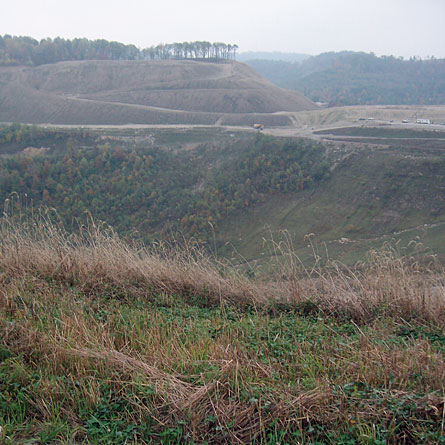Coal Country’s New Foresters
After watching videos of mountaintop-mining impacts on local communities (including poisoned water supplies, catastrophic erosion of downstream residential soils, and local health problems), reporters on a Society of Environmental Journalists field trip to West Virginia coal country were primed to spend a day witnessing horrors and devastation. Imagine our surprise, then, when we learned the second mountain-mining operation that we visited was practicing good environmental stewardship.


This particular operation was even employing state-of-the-art land reclamation techniques — ones pioneered at nearby Virginia Tech.
The surprise, of course, is not that some operations exhibit responsible practices but that such practices are often off the radar screens of the news media and public. Which is, I suspect, why our tour leaders — newspaper reporters in coal country — thought it was important we meet the people at Pritchard Mining, working sites on Four Mile Mountain.
The first surprise: We expected to see another lopped-off mountain summit, denuded of all visible life. Instead, we saw greenery at a number of places and an actual stand of trees atop a tall wall of rock.
We asked Pritchard Mining president Andrew Jordon why that forested area had not been mined. Oh, it has, he assured us, up to about 10 years ago. Then its rocky surface was covered with a layer of topsoil and planted with trees. Young trees.
Today, many of them are now 10 to 15 feet tall. Some of the faster growing ones are even being logged selectively for timber, Jordon told me.
What about that blue-green material we saw thinly blanketing parts of the scraped-clean upper surfaces of KayfordMountain, a few hours earlier?
That funky, grass-seeded stuff doesn’t really reclaim a scarred mountain surface, at least not quickly, noted Virginia Tech forestry professor James A. Burger. He was one of at least seven experts traveling on a bus full of reporters and other SEJ-meeting attendees. Appalachia has been home to the most diverse hardwood forests, Burger notes. Once they’re clear-cut, it generally takes some 300 years for such woodlands to completely recover, he says.
But his 30 years of research has indicated that by planting a mix of the trees that would ultimately dominate mature hardwood forests along with some of the understory trees (such as dogwoods) that would ordinarily fill in the lower reaches, foresters can speed the recovery of woodlands. Perhaps cutting up to 200 years off of the process of achieving mature, harvestable hardwoods.
Key to helping getting a forest reestablished on rocky surfaces, he says, is carpeting them with an engineered soil substitute (small rocks from easily fractured and weathered minerals).
And that’s what Jordon’s company has done. It starts planting trees as soon mining has finished on some part of the mountain. Rocky Hackworth, Pritchard Mining’s vice president and general manager, had just finished overseeing the planting of some 500 trees, we learned.
To date, Jordon says, his 18-year-old company has reclaimed some 2,200 acres of land while mining 1.5 million tons of bituminous coal. An estimated 6 million tons more coal should be recoverable at this site, he says. Pritchard Mining is no longer just an energy company, argues this local-born-and-bred miner: “We are practicing environmentalists.”
Keep in mind that we were directed to the Pritchard operations by the West Virginia Coal Association. Jordon is the immediate past chairman of this Charleston-based industry group. So Jordon’s company might not be representative so much as a good face to a generally very dirty industry. But it does show that money can be made extracting coal in ways that don’t greatly jeopardize the health of its neighbors and permanently scar the local environment.
That said, it may still take the better part of a century before this area, once home to dense stands of hardwoods, regains its towering oaks, maples, hickories and cherries.





